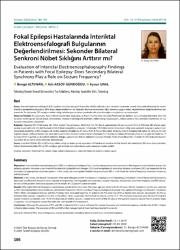| dc.contributor.author | Altunan, Bengü | |
| dc.contributor.author | Gündoğdu, Aslı Aksoy | |
| dc.contributor.author | Ünal, Aysun | |
| dc.date.accessioned | 2022-05-11T14:40:12Z | |
| dc.date.available | 2022-05-11T14:40:12Z | |
| dc.date.issued | 2020 | |
| dc.identifier.issn | 1300-7157 | |
| dc.identifier.uri | https://app.trdizin.gov.tr/makale/TkRreE5Ua3dNQT09 | |
| dc.identifier.uri | https://hdl.handle.net/20.500.11776/8899 | |
| dc.description.abstract | Amaç: İnteriktal elektroensefalografi (EEG) epilepsi hastaları için günlük pratikte sıklıkla kullanılan, tanı ve tedavi sürecinde önemli olan elektrofizyolojik bir testtir. İnteriktal epileptiform deşarjların (İED) doğru değerlendirilmesi ve sekonder bilateral senkroninin (SBS) tanınması uygun tedavi seçeneklerinin değerlendirilmesi için önemlidir. Bu çalışmada, SBS varlığının nöbet sıklığı, lokalizasyon ve tedavi yanıtında rolü olup olmadığının araştırılması amaçlanmıştır. Gereç ve Yöntem: Bu çalışmada, Namık Kemal Üniversitesi Uygulama ve Araştırma Hastanesi Nöroloji Polikliniği’nde epilepsi tanısı ile takip edilmekte olan 126 hastanın verileri geriye dönük olarak incelenmiştir. Hastaların demografik özellikleri, nöbet sıklığı, lokalizasyonu, tedavi yanıtı ve EEG özellikleri incelenmiş ve 122 hastanın sonuçlarına ulaşılmıştır. Bulgular: Olguların 58’i (%46) kadın, 68’i (%54) erkektir. Yaş ortalaması 36.5±16.4 (15–78) olarak saptanmıştır. On beş hastanın (%12.2) EEG’sinin SBS olarak raporlandığı tespit edilmiştir. Elli dört hastada (%44.2) fokal epileptiform anomali, 12 hastada (%9.8) fokal zemin ritmi düzensizliği (non-epileptik bulgular) saptanmıştır. Semiyolojik özellikler ve EEG bulguları ile birlikte değerlendirildiğinde 44 hasta (%34.9) frontal lob nöbet, 66 hasta (%52.4) temporal lob nöbet ve 16 hasta (%12.6) diğerleri olarak sınıflandırılmıştır. Yüz yirmi altı hastanın 46’sı (%36.5) nöbetsiz iken 15 hastada (%11.9) yılda bir nöbet, 46 hastada (%36.5) 1–6 ayda bir nöbet ve 19 hastada (%15.1) günlük ya da haftalık nöbetler olduğu saptanmıştır. Kırkaltı nöbetsiz hastanın 29’unda (%23) erken dönemde, 17’sinde (%13.5) tedavinin başlanmasından altı ay sonra nöbetsizlik elde edilebilmiştir. Sonuç: İnteriktal EEG’de, İED ve SBS varlığı nöbet sıklığı ve tedavi yanıtı açısından risk faktörü olmamakla birlikte frontal lob nöbetlerde SBS oranı daha yüksektir. Tedavi düzenlenmesinde, İED ve SBS varlığının göz önünde bulundurulması yanlış sonuçlara neden olabilir | en_US |
| dc.description.abstract | Objectives: Interictal electroencephalography (EEG) is an electrophysiological test used in daily practice and important in the diagnosis and treatment process for epileptic patients. Accurate assessment of the interictal epileptiform discharges (IEDs) and recognition of secondary bilateral synchrony (SBS) are important for the evaluation of appropriate treatment options. In this study, we investigated whether the presence of SBS is a risk factor for seizure frequency, treatment response, and localization. Methods: In this study, the data of 126 patients who were followed up with the diagnosis of epilepsy in the Neurology Outpatient Clinic of Namık Kemal University Education and Research Hospital were analyzed retrospectively. Demographic characteristics, seizure frequency, localization, treatment response and EEG characteristics of the patients were investigated and the results of 122 patients were obtained. Results: Fifty-eight (46%) of the patients were female, and 68 (54%) were male. The mean age was 36.5±16.4 (15–78) years. EEG of 15 patients (12.2%) was reported as SBS. Focal epileptiform abnormality was detected in 54 patients (44.2%) and focal irregular background activity (non-epileptic findings) was found in 12 patients (9.8%). When semiological features and EEG findings were evaluated together, 44 patients (34.9%) were classified as frontal lobe seizures, 66 patients (52.4%) as temporal lobe seizures, 16 patients (12.6%) as the others. Forty-six patients (36.5%) had no seizures, while 15 (11.9%) had one seizure per year, 46 (36.5%) had one seizure in one to six months, and 19 (15.1%) had daily or weekly seizures. Twenty-nine (23%) of the 46 seizure-free patients became seizure-free in an early stage, 17 patients (13.5%) became seizure-free after the sixth month of the treatment. Conclusion: Although the presence of IED and SBS in interictal EEG is not a risk factor for seizure frequency and treatment response, and the rate of SBS is higher in frontal lobe seizures. The presence of IED and SBS in the management of treatment may lead to false results. | en_US |
| dc.language.iso | tur | en_US |
| dc.rights | info:eu-repo/semantics/openAccess | en_US |
| dc.title | Fokal Epilepsi Hastalarında İnteriktal Elektroensefalografi Bulgularının Değerlendirilmesi: Sekonder Bilateral Senkroni Nöbet Sıklığını Arttırır mı? | en_US |
| dc.title.alternative | Evaluation of Interictal Electroencephalography Findings in Patients with Focal Epilepsy: Does Secondary Bilateral Synchrony Play a Role on Seizure Frequency? | en_US |
| dc.type | article | en_US |
| dc.relation.ispartof | Epilepsi | en_US |
| dc.department | Fakülteler, Tıp Fakültesi, Dahili Tıp Bilimleri Bölümü, Nöroloji Ana Bilim Dalı | en_US |
| dc.identifier.volume | 26 | en_US |
| dc.identifier.issue | 3 | en_US |
| dc.identifier.startpage | 186 | en_US |
| dc.identifier.endpage | 192 | en_US |
| dc.institutionauthor | Altunan, Bengü | |
| dc.institutionauthor | Gündoğdu, Aslı Aksoy | |
| dc.institutionauthor | Ünal, Aysun | |
| dc.identifier.trdizinid | TkRreE5Ua3dNQT09 | en_US |



















